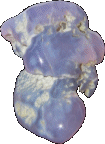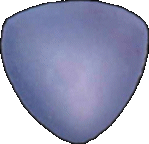| |
Chalcedony
|
The chalcedony has a strange and convoluted history. For modern geologists it is another name for agate, a transparent or semitransparent from of jasper. Early lapidaries group many different agates and jaspers under the name chalcedony and it is only possible to discern which stone they are talking about by the description they give in the text. Where possible this folklore can be found in the modern category, for instance carnelian, agate, or jasper.
For gemologists the modern gemologists reserve the term chalcedony to describe the milky white to blue or bluish-purple variety of agate. This variety was historically referred to as Persian chalcedony due to the prominence that region gave to the gem for its use in jewelry and cylinder seals.
This is a unique stone because unlike other stones the virtues remain consistent throughout history and across many cultures. The white milky variety is the most common, and it was often worn in necklaces to increase lactation.
The more expensive blue variety was accredited with the ability to drive off phantoms, night terrors, and all other incorporeal denizens of the night. Sixteenth century magicians were advised keep chalcedony rings as a means to discharge unwanted "guests" and protect from the "illusions and cunning" of spirits and demons. The power of the chalcedony is later extended in eastern European folklore to protect against vampires and various undead. It should be noted that the claim that the chalcedony could cure melancholy may is directly tied to the belief in the stone’s ability to control spirits since at the time the lapidaries were written many mental health issues were believed to be of supernatural origin.
One of the few variations to this stone’s folklore comes from a 14th century lapidary by Mandeville. In this work he correctly identifies the stone as being milky white to blue, but claims there are three distinct varieties.
The first he claims with protect from weapons and give you victory in battle. His extension of this virtue to protect against deceit and enable the wearer to win arguments is likely tied to the later belief that the stone was a prized by barristers for its assistance in winning cases.
The second was given the more common attributes of the chalcedony in that it protected form spirits and melancholy. In addition, this second type of chalcedony protected from the evil in poison and venom, safeguarded the wearers health, bestowed eloquence, and protected from storms.
The third variety is said to be the rarest and most valuable, and should only be set in gold. It is strange in that this type of chalcedony was supposed to protect from burning and drowning.
The properties of the third variety are theoretically due to the association of the stone’s appearance with water. If this is correct, then it suggest that that the first type was the low grade whiteish variety, the second the standard light blue, and the third the deep blue we usually associate with fine chalcedony today which does happen to be one of the more expensive varieties.
|
Colors
|
Milky white to deep bluish purple
|
Locations
|
Chalcedony is found worldwide.
|
Compisition
|
SiO2, semipellucid crystallized quartz silicate
|
Hardness
|
6 - 7
|
|

|

|

|
|
|
|
|
|